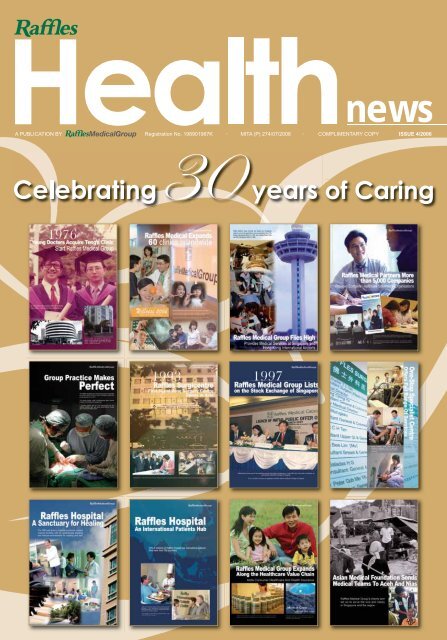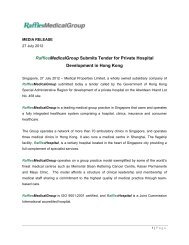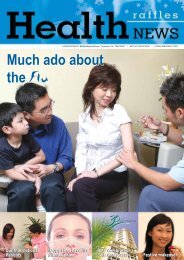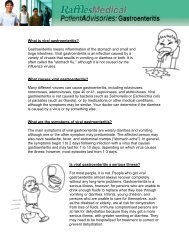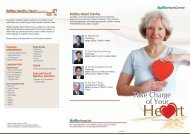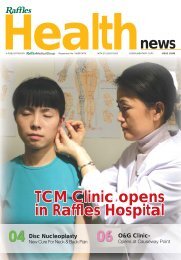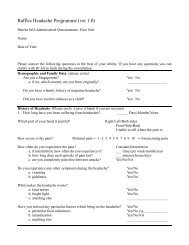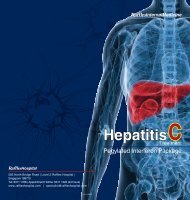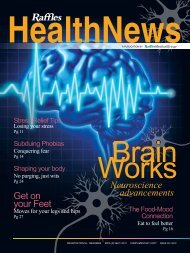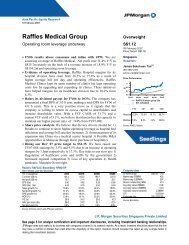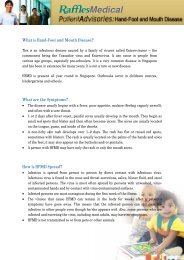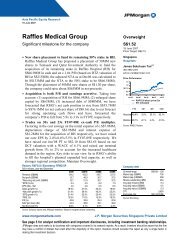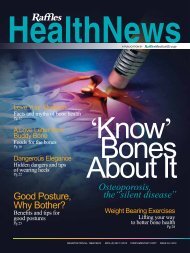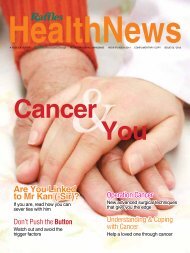News - Raffles Medical Group
News - Raffles Medical Group
News - Raffles Medical Group
Create successful ePaper yourself
Turn your PDF publications into a flip-book with our unique Google optimized e-Paper software.
news<br />
A PUBLICATION BY Registration No. 198901967K . MITA (P) 274/07/2006 . COMPLIMENTARY COPY ISSUE 4/2006
AESTHETIC<br />
Skin<br />
For<br />
By Dr Yeak Hwee Lee, Senior Family Physician and Aesthetics Practitioner,<br />
<strong>Raffles</strong> <strong>Medical</strong> Clinics<br />
Today’s women are amazing. Despite having to straddle<br />
the stresses of work and family, they somehow manage<br />
(and are expected) to look like a superstar.<br />
The most disturbing skin problem in tropical Singapore is<br />
probably acne and acne scarring. It causes such distress<br />
that many suffer from psychological issues (such as poor<br />
self-image) as a result of it.<br />
The more mature women have other grouses, primarily ageing<br />
skin–wrinkling, pigmentation (often aggravated by solar<br />
damage), sagging and loss of youthful glow and firmness<br />
of skin. The quest to restore skin to its youthful vitality has<br />
spawned the multimillion-dollar cosmetic industry.<br />
Pregnant ladies have their own unique set of problems.<br />
Though some ladies experience the rosy glow of pregnancy,<br />
most expectant mothers have to put up with dark blotches<br />
on the skin, hair growth in unusual areas, thinning hair on<br />
their head, rashes, acne, stretch marks, brittle or splitting<br />
nails, and worsening of existing skin conditions.<br />
As one ages, the risk of skin injury is increased as the skin<br />
is thinner, more fragile and the protective subcutaneous<br />
fat layer is lost. In addition, one’s ability to sense touch,<br />
pressure, vibration, heat and cold may be reduced. All<br />
these increase the risks of injury. Rubbing or pulling on<br />
the skin can cause skin tears. Fragile blood vessels are<br />
easily broken. Bruises, flat collections of blood, and raised<br />
collections of blood may form after even a minor injury.<br />
This is most easily seen on the outside surface of the<br />
forearms, but can occur anywhere on the body. Skin changes<br />
and loss of subcutaneous fat, combined with a tendency to<br />
be less active, as well as some nutritional deficiencies and<br />
other illnesses contribute to pressure ulcers.<br />
Ageing skin repairs itself more slowly than younger skin.<br />
Wound healing may be up to four times slower. This<br />
contributes to pressure ulcers and infections. Diabetes,<br />
blood vessel changes, lowered immunity, and similar<br />
factors also affect healing.<br />
Although it is not possible to turn back the hands of<br />
time, its effects can be slowed down and improved with<br />
the arsenal of procedures and techniques available.<br />
Anti-ageing creams such as retinols and alpha<br />
hydroxyacids and topical product like vitamin C and<br />
vitamin E serums are usually used to treat the milder<br />
symptoms of ageing such as damage to the skin’s<br />
uppermost layers. Sun avoidance by using sunscreens<br />
and other physical means such as hats and visors will<br />
help to prevent solar ageing.<br />
For more advanced signs of ageing and sun-damage,<br />
your dermatologist will choose the surgical method or<br />
combination of methods best suited to your individual<br />
skin condition. Here are some treatments that would<br />
refine your appearance and make your skin look and feel<br />
healthy and attractive.<br />
2<br />
<strong>Raffles</strong> Health<strong>News</strong> | Issue 4/2006
are<br />
AESTHETIC<br />
ll Ages<br />
CORRECTIVEPROCEDURES<br />
Chemical Peels<br />
Chemical peels are beneficial in the treatment of wrinkles, skin<br />
discoloration and age spots, as well as dull skin texture and<br />
mild acne scars. A customised chemical solution is applied<br />
to the skin to remove outer layers of aged and sun-damaged<br />
skin. Upon healing, generated new skin is noticeably smoother<br />
and fresher in appearance. A variety of peeling agents can<br />
be used to produce light, medium or deep chemical peels,<br />
depending on the amount of skin damage present.<br />
Facelift<br />
A well-known procedure, facelift removes sagging and<br />
redundant skin, particularly from the lower third of the face<br />
and under the chin. Some dermatologists now perform both<br />
facelifts and eyelid surgery as in-office procedures under<br />
local anaesthesia.<br />
Non-surgical face-lifts such as Thermage using radiowaves<br />
and Titan using infrared technology have deferred the need<br />
for surgical intervention till a later date.<br />
Dermabrasion<br />
Dermabrasion uses a special instrument to remove or abrade<br />
the upper layers of the skin and smooth out irregularities in the<br />
skin surface. Although usually performed to correct scarring,<br />
some physicians perform dermabrasion for substantial sun<br />
damage and pigmentation problems.<br />
Soft Tissue Fillers<br />
Soft tissue fillers involve injecting a filling substance under<br />
the skin. It is used to “plump up” or contour and correct<br />
wrinkles, furrows and hollows in the face. Filling substances<br />
include bovine collagen and related materials, fat removed<br />
from another part of the patient’s body and polymer implants.<br />
Botulinum Toxin (BOTOX)<br />
Botulinum toxin type A is a muscle blockade that is injected in<br />
very tiny amounts into specific muscles to treat and improve<br />
lines, wrinkles and furrows associated with facial expression.<br />
It is also used to immobilise the muscle bands sometimes<br />
visible on the neck.<br />
Laser Resurfacing<br />
Laser resurfacing uses the newest generation of the<br />
carbon dioxide and erbium YAG lasers to vaporise the<br />
undesired skin tissue one layer at a time, revealing fresh<br />
skin underneath. The laser’s highly focused beam enables<br />
the dermatologist to gently and precisely remove the skin’s<br />
surface with low risk of complications.<br />
Non-Ablative Resurfacing<br />
Non-ablative resurfacing has several of the benefits of<br />
traditional laser resurfacing without wounding the top layers<br />
of the skin, providing rapid postoperative healing. They<br />
rejuvenate ageing and sun-damaged facial skin through the<br />
use of non-ablative laser and intense pulsed light technologies<br />
as well as electro-surgical resurfacing using “cold” (low<br />
temperature) electrical energy. This latter technique allows<br />
rapid healing when used to treat wrinkles or scars.<br />
Microdermabrasion<br />
Microdermabrasion uses tiny particles that pass through<br />
a vacuum tube to gently scrape away the ageing skin<br />
and stimulate new cell growth. Because of the superficial<br />
nature of this technique, patients with mild to moderate skin<br />
damage and wrinkles are the best candidates, and multiple<br />
treatments are usually required to achieve subtle results.<br />
For more information or to make an appointment for the procedures above, please call<br />
<strong>Raffles</strong> Aesthetics Centre in <strong>Raffles</strong> Hospital: 6311 1222 (24 hour appointment hotline)<br />
<strong>Raffles</strong> <strong>Medical</strong> Clinic in OUB Centre: 6535 2222 or 6538 0057<br />
Issue 4/2006 | <strong>Raffles</strong> Health<strong>News</strong><br />
3
WELLNESS<br />
<strong>Medical</strong>, Dietary & Exercise Advice For A<br />
SLIMMER YOU<br />
Hands up if you think you could do with some weight loss. You are not alone. A survey by AC Nielsen in 2004 says that 80 per<br />
cent of Singaporeans are attempting to shed some weight. How can this be done? Raffl es Hospital’s experts in their fi elds,<br />
Consultant Endocrinologist Professor Cheah Jin Seng and Dietitian Ms Michelle Funk, as well as California Fitness Regional<br />
Director of Fitness Development Mr Rob Devereux, sheds light on how you can be slimmer.<br />
<strong>Medical</strong> Problems and Weight Loss<br />
By Professor Cheah Jin Seng<br />
Calorie-packed fast food and drinks and increased portion<br />
sizes combined with a sedentary lifestyle have spawned<br />
global obesity.<br />
Half of Singapore’s adult population are either overweight<br />
or obese. Obesity is not only socially and aesthetically<br />
undesirable, it shortens life expectancy and it can result in<br />
many serious and debilitating diseases such as diabetes<br />
mellitus, high blood pressure and heart disease.<br />
Obesity can be due to an underlying<br />
medical problem<br />
While the vast majority of obese people are in the state they<br />
are in due to over-eating and under exercising, a small minority<br />
has underlying medical disorders resulting in the weight gain.<br />
These include hypofunction of the thyroid, hyperfunction of<br />
the adrenal (Cushing’s Syndrome), diminished function of the<br />
gonads and pituitary and rare genetic disorders.<br />
Before undergoing a weight management programme,<br />
it is important that the overweight person consult the<br />
endocrinologist or physician to see if there’s an underlying<br />
cause or if he is suffering from any co-mobidities.<br />
Weight management in the overweight with<br />
co-morbid states<br />
In general, overweight patients with co-morbid disorders have<br />
a greater urgency to lose weight than those without as weight<br />
loss leads to the improvement of the co-morbidites and<br />
medication reduction. An overweight non insulin-dependent<br />
diabetic that loses fi ve to 10 kg may even be cured of the<br />
diabetes! Joint pains (osteoarthritis) are common in the obese;<br />
these subjects can only do limited exercise such as swimming,<br />
walking and cycling. In these patients, reduced caloric intake<br />
and anti-obesity drugs are helpful.<br />
Even modest weight loss is signifi cant in improving the wellbeing<br />
and co-morbidity in the obese. In the morbidly obese<br />
(BMI 37 and above), laparoscopic gastric banding is an<br />
effective and safe option.<br />
Team management is the key to successful<br />
weight management<br />
Together with the help of the physician, dietitian, exercise<br />
therapist, behavioural therapist and surgeon, the overweight<br />
can shed the extra pounds easily.<br />
You are what you eat –<br />
Tips for a successful weight loss!<br />
By Ms Michelle Funk<br />
To lose weight, you need to use up more calories than the<br />
calories consumed. An effective way to do so is to eat less fat<br />
as every gram of fat is double the calories contributed by other<br />
macronutrients like protein and carbohydrate.<br />
1g fat = 9 calories<br />
1g carbohydrate = 4 calories<br />
1g protein = 4 calories<br />
Less fat for a more satisfying and healthier meal<br />
Compare the difference:<br />
1 bowl of prawn noodle, soup 293 calories, 2g fat<br />
1 bowl of prawn noodle, dry 409 calories, 12g fat<br />
1 bowl plain rice 260 calories 0g fat<br />
1 bowl chicken rice 434 calories 9g fat<br />
2 chapati 180 calories, 6g fat<br />
1 prata 317 calories 11g fat<br />
In each set, the amount of food is similarly fi lling. The difference<br />
in calories is due to the different fat content. To make the<br />
higher fat item the same calories as the lower fat item, you’ll<br />
have to eat less of the higher fat item, thus reducing the size<br />
of your meal and your satisfaction level.<br />
Fad diets work... only temporarily<br />
Most people on diets such as low carbohydrate diets or fruit<br />
only diets inevitably put the weight back on. Currently, there is<br />
still insuffi cient data to support the many variation of diets that<br />
are high in protein, high in fat and low in carbohydrate.<br />
Set long-term goals<br />
Set your goal for permanent weight loss by slowly changing<br />
your eating and lifestyle habits. A healthy rate of weight loss is<br />
about half to one kilogramme per week. Do not rush<br />
yourself as rapid and excessive<br />
weight loss is unhealthy.<br />
Take the time to make<br />
changes that you will be<br />
able to continue for a<br />
very long time.<br />
4<br />
<strong>Raffles</strong> Health<strong>News</strong> | Issue 4/2006
Sweat it out!<br />
By Mr Rob Devereux<br />
A good exercise programme should be balanced. It should<br />
comprise cardiovascular exercise, resistance training and<br />
stretching. However, this does not mean that all of these<br />
components need to be incorporated into every training session.<br />
The amount of exercise done in each session is largely<br />
determined by your goals, current fi tness level, and time<br />
available. Everyone who has the physical capacity to do<br />
so should accumulate 30 minutes of moderate intensity<br />
exercise (eg: brisk walk or slow jog) on as many days of the<br />
week as possible.<br />
During exercise, the heart rate should be elevated and<br />
breathing laboured. After exercise the individual should feel<br />
that he has exerted himself but not to the extent that he<br />
feels exhausted.<br />
The main activity focus in weight loss programmes is<br />
cardiovascular exercise because this type of exercise is ideal<br />
for calorie burning. A cardiovascular exercise is any activity<br />
that raises the heart rate through the use of large muscle<br />
groups in a rhythmic nature and that can be maintained for a<br />
relatively long period of time. Brisk walking, jogging, cycling,<br />
swimming and rowing are all examples of cardiovascular<br />
exercises that help burn off the extra calories.<br />
Resistance training should also be incorporated into a<br />
weight loss programme because well trained and toned<br />
muscles have a higher metabolic rate which means that<br />
even at rest they burn more calories than untrained poorly<br />
toned muscles.<br />
A suggested half an hour exercise programme<br />
Here’s a good combination for a weight loss programme.<br />
1. Start off with 20 minutes of your preferred cardiovascular<br />
exercise (eg: swimming, jogging or aerobics).<br />
2. Follow that up with 10 minutes of callisthenics. The<br />
calisthenics could include a circuit of the following<br />
three exercises:<br />
a. Squat down to touch the ground<br />
then standing back up again 15 times<br />
b. Push ups, 15 times<br />
c. Crunches, 15 times<br />
Weight Management Services<br />
Sign up for a <strong>Raffles</strong> Hospital Weight Loss package<br />
which includes four consultations with a Consultant<br />
Endocrinologist, four sessions with a dietitian and<br />
laboratory tests.<br />
Mothers, get back in shape through the Postnatal<br />
Back-to-Shape Package. The package includes a<br />
gynaecologist check-up, a back to shape aesthetic<br />
treatment and dietetic advice.<br />
Special Price of<br />
S$220<br />
Find out what is the appropriate treatment you should<br />
go for to reduce excessive weight quickly and effectively<br />
through the <strong>Raffles</strong> 32 Screening. The package consists<br />
of a specialist consultation, blood tests, electrocardiogram<br />
and an ultrasound of the liver.<br />
Treatments for severe obesity:<br />
Special Price of<br />
S$420 until 31 Dec 06.<br />
Special Price of<br />
S$350 until 31 Dec 06<br />
Intragastric balloon (non-surgical<br />
treatment) is a quick and non-invasive.<br />
treatment to lose weight 6kg to 20kg).<br />
Laparoscopic banding (surgical<br />
treatment) is a reversible keyhole procedure<br />
with minimal scars that will lead to a weight<br />
loss of 20 to 100kg permanently.<br />
In conjunction with California Fitness Jackie Chan Sport,<br />
you can also get a special training package at:<br />
WELLNESS<br />
This circuit of three exercises could be repeated three times to<br />
complete a 10-minute workout for some of the major muscles<br />
of the body.<br />
S$892 for 12 personal training<br />
sessions (to be completed in 6 weeks).<br />
S$848 for 8 personal training<br />
sessions with 3-month gym membership.<br />
or<br />
Email: specialist@raffleshospital.com<br />
Issue 4/2006 | <strong>Raffles</strong> Health<strong>News</strong><br />
5
FITNESS & NUTRITION<br />
Strategies to prevent aches,<br />
pains and injuries<br />
By Mr Lim Hun Teck, Senior Physiotherapist<br />
The back is a well-designed structure made up of<br />
bones, muscles, nerves and other soft tissues. It takes<br />
on the stress of the work and play we do 24 hours a<br />
day. For this reason, the back is particularly vulnerable<br />
to injury. The good news is that back pain and injuries<br />
are avoidable.<br />
Be fit<br />
Regular exercise is one of the best methods to maintain a healthy<br />
spine. Keep your weight in check as being overweight strains<br />
your back muscles. Regular low-impact aerobic activities that<br />
don’t strain your back can increase the strength and endurance<br />
of your back and allow your muscles to function better. Walking<br />
and swimming are good choices.<br />
Abdominal and back muscle exercises help condition these<br />
muscles so that they work together like a natural corset for your<br />
back.<br />
Pay attention to posture<br />
A healthy spine has three natural curves. When these curves<br />
are in their proper position, we have good posture. Poor posture<br />
stresses your back. When you slouch or stand with a swayback,<br />
you exaggerate your back’s natural curves. This can lead to<br />
muscle fatigue and injury. In contrast, good posture relaxes your<br />
muscles and requires minimal effort to balance your body.<br />
Correct standing posture<br />
When standing, imagine that someone is making you taller<br />
by pulling a string attached to the top and back of your head.<br />
Tighten your pelvic fl oor muscles and your tummy muscles to<br />
support your back in this posture. If you view from the side, a<br />
good standing posture is where your ear, shoulder and knee fall<br />
along a straight line. If you stand for long periods, rest one foot<br />
on a stool or small box from time to time.<br />
Correct sitting posture<br />
To promote comfort and good posture while sitting, choose<br />
a chair that supports your back. Adjust the chair so that your<br />
back and upper back is supported by the backrest. If the chair<br />
doesn’t support your lower back’s curve, place a rolled towel or<br />
small pillow behind your lower back. Place the feet on a stool<br />
if they are not resting on the fl oor. Hold reading material at eye<br />
level and don’t bend forward when reading or working.<br />
Correct sleeping posture<br />
The best lying or sleeping posture may vary, depending on your<br />
symptoms. Try to sleep in a position which helps to maintain the<br />
curve in the back. Eg, lying on your back with a pillow under the<br />
knees or on the side with the knees slightly bent.<br />
People with back pain have commonly been told to use a fi rm<br />
mattress. Recent studies, though, indicate that a medium-fi rm<br />
mattress might be better. However, the type of mattress to be<br />
used still depends on the condition of the back. Do use pillows<br />
for support but do not use a pillow that is either too thin or too<br />
thick that forces your neck into a severe angle.<br />
6<br />
<strong>Raffles</strong> Health<strong>News</strong> | Issue 4/2006
Lift smart<br />
If you have to carry anything, hold it close to your body, bend<br />
your knees rather than your back (as if squatting) and try not<br />
to twist. When shopping, divide your purchases into two equal<br />
loads and carry one bag in each hand. Do recruit help if the<br />
load is too heavy.<br />
Reduce stress<br />
Stress causes you to tense your muscles, and this can make you<br />
more prone to injury. Try to minimise your sources of stress both on<br />
the job and at home. Develop coping mechanisms for times when<br />
you feel especially stressed. For instance, perform deep-breathing<br />
exercises or talk out your frustrations with a trusted friend.<br />
Tips to manage back pain<br />
Keep moving<br />
Prolonged bed rest may result in wasting of the back muscles<br />
and hinder the healing process. Light activity speeds healing<br />
and recovery. If the back hurts, stop the aggravating activities<br />
but try to keep activities that aren’t painful.<br />
Apply cold or heat<br />
Hot bath and hot or cold compresses, can soothe sore and<br />
infl amed muscles. Use cold treatment immediately after injuring<br />
your back; apply ice pack or cold compress several times a day,<br />
for up to 20 minutes at a time. Wrap the cold compress with<br />
a cloth or towel to keep a thin barrier between the equipment<br />
and the skin. Use for as long as spasms persist. After spasms<br />
and acute pain subside, you can apply heat from a heating<br />
pad or heat lamp to help loosen tight muscles. Limit each heat<br />
application to 20 minutes.<br />
Use pain relievers<br />
Your doctor may prescribe nonsteroidal anti-infl ammatory<br />
drugs or in some cases, a muscle relaxant, to relieve mild to<br />
moderate back pain that doesn’t get better with overthe-counter<br />
pain relievers<br />
When to seek medical advice<br />
Most back pain gradually improves with home treatment<br />
and self-care. Although it may take several weeks<br />
before it completely disappears, you should notice some<br />
improvement within the fi rst 72 hours of self-care. If not,<br />
see your doctor or physiotherapist<br />
In rare cases, back pain can signal a serious medical<br />
problem. See a doctor or physiotherapist<br />
immediately if your back pain:<br />
Is constant or intense, especially when lying down or<br />
at night<br />
Spreads down one or both legs<br />
Causes weakness, numbness or tingling in one or<br />
both legs<br />
Causes new bowel or bladder problems<br />
Is associated with abdominal pain or pulsation<br />
(throbbing), or fever<br />
Follows a fall, blow to your back or other injury<br />
Is accompanied by unexplained weight loss<br />
Also, see your doctor if the pain is new and you’re<br />
older than age 50 or have a history of cancer,<br />
osteoporosis, steroid use, or drug or alcohol abuse.<br />
<strong>Raffles</strong> Physiotherapy Centre<br />
can help you with:<br />
Back and neck pain or stiffness<br />
Muscle strains/contusions<br />
Joint sprains/stiffness/instability<br />
Arthritis<br />
Muscle imbalances/weakness<br />
Muscle spasm<br />
Tendonitis/bursitis<br />
Rehabilitation following occupational injury,<br />
surgery, sporting injuries.<br />
FITNESS & NUTRITION<br />
Using brace or corset<br />
They can provide warmth, comfort and a degree of support to<br />
your back. But it’s best to use a brace or corset only for short<br />
periods or during back-straining activities. Prolonged usage of<br />
the brace or support may weaken the muscles of the back, if at<br />
all. The best brace or corset you can give yourself is your own<br />
“muscle corset.” You can build up your muscle corset through<br />
back strengthening and stability exercises.<br />
For more information or to make an appointment with our physiotherapist, please call our<br />
Appointments Hotline: 6311 1222<br />
or<br />
Email: specialist@raffleshospital.com<br />
Issue 4/2006 | <strong>Raffles</strong> Health<strong>News</strong><br />
7
CORPORATETSCENE<br />
Dinner guests were each given a copy of the <strong>Raffles</strong> <strong>Medical</strong> commemorative book. Guest of Honour DPM Wong Kan Seng received the first copy.<br />
Raffl es <strong>Medical</strong> <strong>Group</strong> celebrated its 30th anniversary on<br />
29 July this year with a gala dinner, a charity drive and the<br />
launch of a commemorative book.<br />
The dinner was held at Raffl es City Convention Centre, and<br />
is also meant as an opportunity to thank the <strong>Group</strong>’s more<br />
than 1 million patients as well as corporate clients from<br />
5,000 companies for their unwavering support over the past<br />
30 years.<br />
their patients. This vision is translated into a private group<br />
practice model of integrated care which is unique in a setting<br />
in Singapore where solo private practice is the norm, extends<br />
from the <strong>Group</strong>’s GP services to its specialist services, and<br />
to its practices overseas.<br />
The <strong>Group</strong> currently manages a network of 60 family medicine<br />
and dental clinics covering the island and providing care for<br />
our patients where they work and live.<br />
8<br />
A special commemorative book titled “A Journey of Faith –<br />
the Raffl es <strong>Medical</strong> Story” was launched during the dinner.<br />
The book chronicles the history and development of Raffl es<br />
<strong>Medical</strong> <strong>Group</strong> that started in 1976 as a two-clinic GP<br />
practice to become one of the largest integrated healthcare<br />
organisations in Singapore and the region.<br />
Raffl es <strong>Medical</strong> <strong>Group</strong> was founded by partners Dr Loo<br />
Choon Yong and Dr Alfred Loh with the simple vision of<br />
working as a team to provide the best personalised care for<br />
<strong>Raffles</strong> Health<strong>News</strong> | Issue 4/2006<br />
Its fl agship tertiary hospital – the 380-bed Raffl es Hospital<br />
- offers a wide range of specialist medical and diagnostic<br />
services that span across more than 40 specialties.Five years<br />
since its opening, Raffl es Hospital has already garnered a<br />
reputation of being able to perform some of the most<br />
complex surgeries, as well as a destination of choice among<br />
international patients who comprise 36% of the hospital’s<br />
patients.<br />
Over the years, the <strong>Group</strong> has expanded regionally, with clinic<br />
operations in Hong Kong and representation in a number of<br />
cities in the region.
CORPORATESCENE<br />
The AMF had sent medical teams to Aceh and Nias in 2004 and 2005 respectively.<br />
The <strong>Group</strong> has also evolved along the healthcare value<br />
chain to include health insurance through International<br />
<strong>Medical</strong> Insurers, its specialist healthcare insurance unit,<br />
and consumer healthcare through <strong>Raffles</strong> Health Pte<br />
Ltd–a subsidiary set up to develop and distribute quality<br />
vitamins, supplements and medical diagnostic equipment<br />
in Singapore and the region.<br />
As <strong>Raffles</strong> <strong>Medical</strong> <strong>Group</strong> grows, it aims not only to bring its<br />
brand of healthcare to more people in more communities<br />
but to harness its professional expertise and resources to<br />
serve the sick and underprivileged in the region.<br />
The AMF also despatched medical teams and supplies to<br />
the Nias Earthquake of 28 March 2005.<br />
Looking ahead, the AMF plans to send missions overseas<br />
to provide assistance with and training in organising or<br />
provision of specifi c health care services. These could range<br />
from primary care services (such as vaccinations and care<br />
of sick children) to specialised services to planning and<br />
management of hospitals or healthcare systems.<br />
This commitment to serving the community is undertaken<br />
by The Asian <strong>Medical</strong> Foundation (AMF), the <strong>Group</strong>’s<br />
humanitarian arm.<br />
Incorporated as an Institute of Public Character in<br />
November 2003, the AMF will leverage on its core<br />
competencies – medical expertise, skills in emergency<br />
medicine and health education – to meet specific needs.<br />
The first activity of the AMF was in 2004 when it adopted<br />
the Ling Kwang Home for Senior Citizens, and raised<br />
funds to support its residents with medical equipment and<br />
daily necessities.<br />
During the Asian Tsunami Disaster of 2005, the AMF sent<br />
humanitarian and fi nancial aid to disaster victims in Aceh,<br />
Indonesia. In collaboration with Munich Reinsurance<br />
Singapore, it despatched a medical team of two doctors and<br />
two nurses to Aceh to treat 1,000 survivors.<br />
The AMF raised $200,000 through the charity Golf event in April.<br />
As part of the programmes of its 30th Anniversary<br />
celebrations, the <strong>Group</strong> raised $200,000 for the Foundation<br />
earlier this year through a charity golf donation drive. The<br />
cheque was presented to the Board Of Trustees of the AMF<br />
at the Anniversary Celebration Dinner. The money raised will<br />
be used to meet the needs of the underprivileged, particularly<br />
those requiring urgent medical treatment.<br />
Issue 4/2006 | <strong>Raffles</strong> Health<strong>News</strong><br />
9
NEWSERVICES<br />
Do your staff dread work? Have you noticed that certain<br />
persons in office are under-performing due to issues in<br />
their personal life or work?<br />
Companies invest significant amounts of time and money on<br />
their workforce. It only makes sense to support employees<br />
to protect this investment and demonstrate commitment<br />
to them.<br />
The Employee Assistance Programme (EAP) is one such<br />
programme. A workplace-focused programme, the EAP<br />
assists to identify and resolve employee concerns such as<br />
work stress, issues in working relationships, family problems<br />
and bereavement which may affect one’s work performance.<br />
The programme provides professional assistance such as<br />
counselling to help employees cope with their work-related<br />
or personal problems. Through a systematic approach, the<br />
programme identifi es the employee’s problem and sets out to<br />
fi nd a solution while maintaining the strictest of confi dentiality.<br />
The provision of an EAP is a practical way of demonstrating<br />
that the organisation has a sincere interest in the well being<br />
of its employees.<br />
10<br />
<strong>Raffles</strong> Health<strong>News</strong> | Issue 4/2006
EAP<br />
programme components<br />
NEWSERVICES<br />
Lifestyle and Health Survey<br />
This online survey may be done as a mental health survey, or as<br />
a lifestyle and health survey which provides a physical and mental<br />
health status inventory of the employees of the company.<br />
Telephone counselling<br />
This is a telephone hotline service manned by qualifi ed and<br />
experienced counsellors, whom employees can call for<br />
assistance when they need to.<br />
Face to face consultations<br />
The service provides your employees the advantage of faceto-face<br />
consultation sessions with a counsellor, psychologist<br />
or psychiatrist. Face-to-face consultations or counselling<br />
sessions are useful to help employees discover their own<br />
strengths, skills and resources to move towards a solution.<br />
Talks / Workshops<br />
Talks or workshops conducted by our specialists may be<br />
organised for your management staff and/or employees.<br />
These talks and workshops are always workplace focused<br />
and will advise what the employer and employee needs to<br />
do to move on. Some examples include Anger Management,<br />
Anxiety Management, Counselling and Support Skills, and<br />
Success Over Stress.<br />
Quarterly reports to companies<br />
Companies will also be provided with a quarterly report<br />
comprising aggregated data on utilisation and problems raised<br />
by employees. The reports will not include any information that<br />
will infringe on the privacy of the individual using the services.<br />
Some examples of the reports include number of calls received<br />
by counsellors for telephone counselling, number of staff who<br />
require individual counselling sessions and the main problems<br />
presented by staff.<br />
Benefits of the<br />
Companies who have participated in the EAP<br />
have found that many benefits can be gained<br />
by implementing an EAP. These include:<br />
Enhanced Performance And Productivity<br />
Optimum Levels Of Workforce Efficiency<br />
Reduced Healthcare Costs<br />
Reduced Absenteeism<br />
Improves Attraction And Retention Of Talent<br />
Improved Health And Well Being Of Employees<br />
Improved Customer Satisfaction<br />
Assistance For Organisational Change<br />
Promotes A Positive Company Image<br />
Raffl es Counselling Centre provides a comprehensive programme to suit the individual needs of your organisation.<br />
To fi nd out more about the Employee Assistance Programme, call our Hospital Marketing hotline at<br />
Appointments Hotline: 6311 2228<br />
or<br />
Email: specialist@raffleshospital.com<br />
Issue 4/2006 | <strong>Raffles</strong> Health<strong>News</strong><br />
11
REGIONALOFFICE<br />
<strong>Raffles</strong> Hospital<br />
expands to more<br />
overseas locations<br />
Our Representative Offices<br />
will assist you with:<br />
Information and answer to queries<br />
Booking of medical appointments<br />
Travel documents & VISA application<br />
Counselling on medical procedures<br />
and more...<br />
For more information on our overseas<br />
Representative Offi ces, call our International<br />
Marketing department at 6311 1111<br />
Indonesia<br />
PT <strong>Raffles</strong> Medika Indonesia<br />
Address: Jl. Wolter Monginsidi 3,<br />
Jakarta 12110, Indonesia<br />
Phone: 62-21-7251 656<br />
Fax: 62-21-7204 916<br />
Email: rhindo@cbn.net.id<br />
To serve an ever-increasing number of overseas patients from regional countries,<br />
Raffl es Hospital plans to set up new Representative Offi ces in Myanmar, Sri<br />
Lanka and India – in addition to existing markets in Indonesia, Bangladesh and<br />
more recently, Vietnam.<br />
The hospital has been appointing more Associates who will assist all potential<br />
clients with enquiries, appointments and travel arrangements. Currently, the<br />
hospital has associates in 12 countries and representation in fi ve.<br />
Explaining the rationale behind this move, Dr Saw Chit Aung, Deputy Director<br />
of International Marketing said: “The standard of living in the regional countries<br />
have improved substantially over the last few years. These foreign patients have<br />
grown affl uent, can afford quality medical care and are willing to pay for better<br />
standards of service. Their search for quality healthcare brings them to Raffl es<br />
Hospital in Singapore.”<br />
Representative offi ces and associates act as medical referral centres to help<br />
patients gain access to specialist and hospital services quickly and effi ciently.<br />
Patients can expect a high level of quality care no matter which country they<br />
are from.<br />
Bangladesh<br />
Dhaka Representative Office<br />
Address: City Heart (9th fl oor),<br />
67 Naya Paltan, Dhaka 1000,<br />
Bangladesh<br />
Phone: 9334963, 9330676,<br />
9362624, 9353046<br />
Fax: 880-2-8314 306<br />
Email: rhbdesh@bdcom.net<br />
Vietnam<br />
<strong>Raffles</strong> Hospital Liaison Centre,<br />
Family Care International Clinic<br />
Address: 35 Pham Ngoc Thach St,<br />
Ward 6 District 3, Ho Chi Minh City,<br />
Vietnam<br />
Phone: 84-8-8222 713<br />
Mobile: 0903 934 717<br />
Fax: 84-8-8296 205<br />
Email: rh_hcmc@healthsolutionsvn.com<br />
12<br />
<strong>Raffles</strong> Health<strong>News</strong> | Issue 4/2006
Managing Screen Time<br />
By Dr Rosebeth R. Marcou<br />
HEALTHTIPS<br />
Andrew’s parents are concerned. Their 9-year-old son has lost<br />
interest in everything but Runescape and the latest Nintendo DS<br />
game. Lately, he does not seem to have energy even for legos<br />
or his soccer practices.<br />
The root of the problem may lie in his bedroom.<br />
Like typical doting parents, Andrew’s parents<br />
want him to have the best of everything. So<br />
Andrew’s room is equipped with a fl at screen<br />
TV, Game Cube, PS II and laptop.<br />
But bogged down with homework<br />
in the day, Andrew can hardly fi nd<br />
any time for computer games, to<br />
squeeze in some playing time,<br />
Andrew sneaks up at 4am – plays<br />
an hour of Runescape – and<br />
then quickly goes back to bed<br />
so that his parents think he<br />
has slept through the night.<br />
While there are confl icting studies as to the mid term impacts<br />
of excessive screen time. It is clear many forms of electronic<br />
entertainment are essentially ‘passive’. Players have to add<br />
very little from their own imagination to play, and the possibilities<br />
are highly scripted.<br />
There may also be an association with the increased rates of<br />
childhood obesity.<br />
As is true for many aspects of childhood, learning to do things<br />
in moderation is achievable.<br />
Children need to understand that if they are doing their<br />
school work well, playing successfully with their peers and<br />
demonstrating other interests – then some screen time each<br />
day can be relaxing and diverting, but that their parents will<br />
not permit it as a sole pre-occupation.<br />
Know you are serving your child’s needs best; in spite of the<br />
protests you might hear at fi rst!<br />
Andrew is not alone in<br />
his problem. For many<br />
children, electronic<br />
entertainment holds an<br />
extreme and sometimes<br />
inexplicable allure. It even<br />
shapes the way they<br />
interact with others. 11-<br />
year-old boys for example,<br />
often select their friends<br />
based on gaming systems.<br />
Though not always approving of this video<br />
game addiction, parents sometimes give in,<br />
believing that there is some value to small-motor<br />
coordination of gaming activities.<br />
Unfortunately, the truth is that there is very little carryover value<br />
in these highly repetitive movements. Furthermore, the young<br />
child who is simultaneously listening to music, talking on the<br />
phone, using Messenger and doing homework is not learning<br />
to multitask so much as they are not devoting enough focused<br />
attention to any of the given tasks. A child who needs a high level<br />
of instant stimulation is vulnerable when it comes to a range of<br />
more ‘tedious’ academic tasks.<br />
So what is a parent to do?<br />
First, do not feel guilty about applying limits. The intense<br />
stimulation is not an ‘entitlement’ of childhood. Children will<br />
protest initially, but after a few weeks, they will fi nd themselves<br />
rediscovering other pleasures and interests long left aside.<br />
Help your child to develop a healthy balance with regards<br />
to ‘screen time.’ If they have electronic entertainment in their<br />
bedroom, consider removing it as a fi rst step. If the TV/gaming or<br />
computer systems are centralised they can become part of family<br />
weekend fun and you can monitor content more consistently.<br />
DR ROSEBETH R. MARCOU – M.D., F.A.A.P.<br />
Qualification and Experiences<br />
American Board Certifi ed Developmental -Behavioral Pediatrician.<br />
MIT (BS), University of Pennsylvania (MD), Stanford University<br />
Hospitals (Residency) and Boston Children’s Hospital<br />
Worked in Alaska, Texas, and Jakarta.<br />
Worked extensively with educators and schools, regularly conducting<br />
training for teachers and parents throughout Asia.<br />
Area of Specialisation<br />
Evaluates and manages patients with concerns including: Attention<br />
Defi cits, Learning Differences / Disabilities, Developmental Delays,<br />
Autism Spectrum Disorders and general behavioral issues.<br />
Identifying and enhancing children’s strengths to help meet their<br />
challenges, always mindful of neurological and medical factors.<br />
Interest<br />
Children/adolescents with incompletely understood diffi culties with<br />
learning or with challenging temperaments.<br />
Focus on describing what is unique about the child- and helping<br />
the child to understand himself or herself.<br />
Dr Marcou will begin seeing patients in the Raffl es Children’s<br />
Centre at Raffl es Hospital on 14 August 2006.<br />
Issue 4/2006 | <strong>Raffles</strong> Health<strong>News</strong><br />
13
SERVICES<br />
New<br />
Satellite Japanese Clinic<br />
The new Japanese satellite clinic at Liang Court opened this year on 27 May to<br />
offer Japanese patients residing around the River Valley area greater convenience<br />
and more choices.<br />
Opens<br />
Skin<br />
In Liang Court<br />
Located at Liang Court Shopping Centre and on the same level as the popular Meidiya<br />
Supermarket, the Clinic provides GP services to the growing Japanese population<br />
in Singapore. Its choice location allows for the Japanese expatriates living in the area<br />
to see the doctor and run other errands within the same building.<br />
For<br />
Presently, the family physicians serving in the Clinic are Dr Onishi Yoichi and Dr<br />
Nagayama Kenichi. For patients looking for quality healthcare and shopping, Liang<br />
Court’s Raffl es Japanese Clinic is the ideal place to go to.<br />
<strong>Raffles</strong> Japanese Clinic – Liang Court<br />
177C River Valley Road<br />
#B1-09 Liang Court Shopping Centre Singapore 179036<br />
To make an appointment, please contact us at our<br />
Liang Court Clinic: 6334 1175<br />
<strong>Raffles</strong> Hospital : 6311 2290<br />
or<br />
Email: j-clinic@rafflesmedical.com<br />
<strong>Raffles</strong> Japanese Clinic – <strong>Raffles</strong> Hospital<br />
585 North Bridge Road<br />
Level 12, Singapore 188770<br />
<strong>Raffles</strong> Japanese Clinic<br />
Operating hours:<br />
Mon – Fri 9.45am – 1.00pm<br />
2.45pm – 6.00pm<br />
Sat<br />
9.45am – 12.30pm<br />
64 Slice CT Coronary Angiogram<br />
PROMOTION<br />
S$882.00U.P.<br />
S$980.00<br />
Extended to 30 Sept 2006<br />
Benefits:<br />
Non-invasive Fast (45 & females aged >55<br />
Hypertension<br />
High cholesterol<br />
Family history of heart disease<br />
Smoker<br />
Diabetic<br />
Peripheral vascular diseases<br />
Previous coronary stenting<br />
Symptomatic Factors<br />
Chest pain upon physical exertion<br />
Previous open heart surgery<br />
Previous coronary stent insertion<br />
64 Slice CT Scanner<br />
For more information or to make an appointment, please call<br />
Appointments Hotline: 6311 1222<br />
or<br />
Email: specialist@raffleshospital.com<br />
14<br />
<strong>Raffles</strong> Health<strong>News</strong> | Issue 4/2006
Vaccination<br />
are Packages for baby’s<br />
ll<br />
first<br />
Ages<br />
2 years<br />
Immunisation protects your baby against infectious diseases,<br />
which can cause serious damage to his/her health.<br />
PROMOTIONS<br />
Sign up for a Vaccination Package now to give your<br />
baby the needed protection.<br />
Our packages comprise a course of vaccinations and<br />
paediatrician consultation and developmental assessment<br />
(including checking of vision, hearing, refl exes and gross<br />
motor development).<br />
1st to 6th Months<br />
1mth<br />
3mth<br />
4mth<br />
6mth<br />
Hep B<br />
5-in-1<br />
5-in-1<br />
6-in-1<br />
OR<br />
2nd to 6th Months<br />
2mth<br />
4mth<br />
6mth<br />
6-in-1<br />
5-in-1<br />
6-in-1<br />
13th to 18th Months<br />
13mth Chickenpox<br />
15mth Measles, Mumps & Rubella<br />
18mth 5-in-1 Booster<br />
Enjoy greater savings if you take up the 13–18 Months Package<br />
with any of the first 6 Months Package!<br />
5-in-1 consists of Diphtheria, Tetanus, Pertussis, Poliomyelitis & Haemophilus Infl uenzae B<br />
6-in-1 consists of 5-in-1 and Hepatitis B<br />
Optional Vaccination Available<br />
– Measles, Mumps and Rubella in 3 separate vaccines<br />
– Rotarix<br />
– Prevenar for Streptococcus Pneumoniae<br />
– Hepatitis A<br />
To contact our clinic staff for more details on the<br />
vaccination packages, please call:<br />
<strong>Raffles</strong> Children’s Centre Tel: (65) 6311 1270<br />
Opening hours convenient for working parents<br />
Mon – Fri 8.30am – 10.00pm<br />
Sat<br />
8.30am – 1.00pm<br />
Sun/PH 9.00am – 12.30pm<br />
Issue 4/2006 | <strong>Raffles</strong> Health<strong>News</strong><br />
15
RCMPACKAGES<br />
<strong>Raffles</strong> Chinese Medicine Packages<br />
WELLNESS PROGRAMME<br />
Insomnia Management<br />
Weekly acupuncture treatment for shallow sleep, inability to fall asleep<br />
and failure to restore mental and physical vigour with sleep.<br />
Migraine Relief<br />
Weekly acupuncture treatment for relief of migraine condition.<br />
General Well Being<br />
Weekly acupuncture treatment for fatigue, loss of appetite, low<br />
immunity and digestive problem.<br />
Weight Management Packages<br />
Weight Loss Programme<br />
Weight Maintenance Programme<br />
PAIN MANAGEMENT PROGRAMME<br />
Acupuncture treatment package for tennis elbow, arthritis, frozen<br />
shoulder, muscle tension and pain, tingling, weakness or numbness in<br />
the neck, back, arm, wrist or feet.<br />
WOMEN’S HEALTH PROGRAMME<br />
Menopause Management<br />
3 month programme for management of conditions arising due to premenopausal<br />
hormonal changes.<br />
RESPIRATORY CONDITIONS RELIEF PROGAMME<br />
Asthma Relief Package A<br />
Choice of two acupuncture weekly treatment packages for treatment of<br />
asthma conditions.<br />
Sinus Relief<br />
Choice of two acupuncture weekly treatment packages for treatment of<br />
sinus conditions.<br />
HEALTHY HEART AND MICROCIRCULATION<br />
Cholesterol Control<br />
Weekly acupuncture treatment for cholesterol level management.<br />
Diabetes Management<br />
Weekly acupuncture for management of diabetes.<br />
The above offers are valid till 31 October 2006.<br />
RCM reserves the right to withdraw the packages without prior notice.<br />
S$200 (U.P. S$230)<br />
S$230 (U.P. S$270)<br />
S$200 (U.P. S$230)<br />
S$600 (U.P. S$668)<br />
S$360 (U.P. S$400)<br />
S$600 (U.P. S$668)<br />
S$380 (U.P. S$440)<br />
Premenstrual Tension Management<br />
3 month programme for treatment of painful or irregular menstruation. S$250 (U.P. S$330)<br />
S$190 (U.P. S$240)<br />
S$190 (U.P. S$240)<br />
S$200 (U.P. S$230)<br />
S$230 (U.P. S$280)<br />
For an appointment, please contact us at<br />
Appointments Hotline: 6311 2388 or Email: specialist@raffleshospital.com<br />
DIRECTORY<br />
<strong>Raffles</strong> Hospital<br />
585 North Bridge Road Singapore 188770<br />
www.raffl eshospital.com<br />
General Enquiries 6311 1111<br />
Call Centre Fax No. 6311 2136<br />
International Patients Centre Fax No. 6311 2333<br />
24 Hour Emergency 6311 5555<br />
Admissions / Business Offi ce 6311 1888<br />
Family Medicine Centre 6311 2233<br />
Raffl es International Patients Centre 6311 1666<br />
Physiotherapy Centre 6311 2350<br />
Radiology 6311 1290<br />
<strong>Raffles</strong> Specialist Centre<br />
24 Hour Appointments Hotline 6311 1222<br />
Fax No. 6311 2136<br />
Email<br />
specialist@raffl eshospital.com<br />
Raffl es Aesthetics Centre<br />
Raffl es Cancer Centre<br />
Raffl es Children’s Centre<br />
Raffl es Chinese Medicine<br />
Raffl es Counselling Centre<br />
Raffl es Dental<br />
Raffl es Eye & ENT Centre<br />
Raffl es HealthScreeners<br />
Raffl es Heart Centre<br />
Raffl es Internal Medicine Centre<br />
Raffl es Japanese Clinic<br />
Raffl es Orthopaedic Centre<br />
Raffl es Surgery Centre<br />
Raffl es Women’s Centre<br />
<strong>Raffles</strong> <strong>Medical</strong> <strong>Group</strong><br />
www.raffl esmedical.com<br />
Corporate Accounts Enquiries 6311 1333<br />
Fax No. 6311 2383<br />
Singapore Clinics 6311 1111<br />
Fax No. 6311 2392<br />
• Anchorpoint 6479 3818<br />
• Ang Mo Kio 6453 2288<br />
• Anson 6225 2188<br />
• Bedok 6441 1736<br />
• Bishan 6456 7122<br />
• Capital Tower 6323 5212<br />
• Causeway Point 6894 0777<br />
• Clementi 6872 9043<br />
• Compass Point 6881 7337<br />
• Grand Plaza 6333 0551<br />
• Harbour Front 6273 3078<br />
• Hougang Central 6386 7896<br />
• JTC Summit 6563 2622<br />
• Jurong East 6899 6688<br />
• Jurong West - Family Doctors 6565 7969<br />
• Lot 1 6765 3363<br />
• Loyang Point 6585 3333<br />
• Marina Square 6339 6644<br />
• Millenia Walk 6337 6000<br />
• Ngee Ann City 6734 7355<br />
• Ogilvy Centre 6223 1188<br />
• OUB Centre* 6535 2222<br />
• Raffl es Airport <strong>Medical</strong> Centre<br />
Passsenger Terminal Two* 6543 1118<br />
Airport Transit One 6543 1113<br />
Airport Transit Two 6543 1118<br />
Changi Cargo Complex 6543 1038<br />
• Raffl es City 6339 6911<br />
• Raffl es Hospital<br />
24 Hour Emergency 6311 1555<br />
Family Medicine Centre 6311 2233<br />
• Siglap 6442 0488<br />
• Tampines DBS 6788 6833<br />
• Tampines Junction* 6788 2222<br />
• Toa Payoh 6254 7667<br />
• Yishun 6755 0049<br />
* Clinics with X-ray Facilities<br />
Hong Kong Clinics (852) 2525 1730<br />
Regional Representative Offices/<br />
Liaison Centres<br />
Indonesia<br />
PT Raffl es Medika Indonesia 62 21 7251 656<br />
Fax No. 62 21 7204 916<br />
Bangladesh<br />
Dhaka Representative Offi ce 933 4963/933 0676/<br />
9362 624/935 3046<br />
Fax No. 880 2 8314 306<br />
Vietnam<br />
Raffl es Hospital Liaison Centre 84 8 8222 713<br />
Fax No. 84 8 8296 205<br />
Editorial Board<br />
Lawrence Lim, Liang Hwee Ting,<br />
Jason Lim & Magdalene Lee.<br />
The information contained in this publication should not be regarded<br />
as a substitute for detailed medical advice in individual cases.<br />
Please address all correspondence to<br />
The Editor, Raffl es Healthnews,<br />
Fax no. 6311 2383.<br />
Raffl es Healthnews is published by<br />
Raffl es <strong>Medical</strong> <strong>Group</strong> Ltd,<br />
585 North Bridge Road, Raffl es Hospital<br />
#11-00, Singapore 188770.<br />
Design and Production by Creative Essence • Aug 2006


